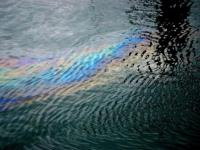Chemicals meant to break up BP oil spill present new environmental concerns
 Rainbow of colors reflecting off oil on water. CC photo by polandeze
Rainbow of colors reflecting off oil on water. CC photo by polandeze
by Abrahm Lustgarten, ProPublica
The chemicals BP is now relying on to break up the steady flow of leaking oil from deep below the Gulf of Mexico could create a new set of environmental problems.
Even if the materials, called dispersants, are effective, BP has already bought up more than a third of the world’s supply. If the leak from 5,000 feet beneath the surface continues for weeks, or months, that stockpile could run out.
On Thursday BP began using the chemical compounds to dissolve the crude oil, both on the surface and deep below, deploying an estimated 100,000 gallons. Dispersing the oil is considered one of the best ways to protect birds and keep the slick from making landfall. But the dispersants contain harmful toxins of their own and can concentrate leftover oil toxins in the water, where they can kill fish and migrate great distances.
The exact makeup of the dispersants is kept secret under competitive trade laws, but a worker safety sheet for one product, called Corexit, says it includes 2-butoxyethanol, a compound associated with headaches, vomiting and reproductive problems at high doses.
“There is a chemical toxicity to the dispersant compound that in many ways is worse than oil,” said Richard Charter, a foremost expert on marine biology and oil spills who is a senior policy advisor for Marine Programs for Defenders of Wildlife and is chairman of the Gulf of the Farallones National Marine Sanctuary Advisory Council. “It’s a trade off – you’re damned if you do damned if you don’t -- of trying to minimize the damage coming to shore, but in so doing you may be more seriously damaging the ecosystem offshore.”
BP did not respond to requests for comment for this article.
Dispersants are mixtures of solvents, surfactants and other additives that break up the surface tension of an oil slick and make oil more soluble in water, according to a paper published by the National Academy of Sciences. They are spread over or in the water in very low concentration – a single gallon may cover several acres.
Once they are dispersed, the tiny droplets of oil are more likely to sink or remain suspended in deep water rather than floating to the surface and collecting in a continuous slick. Dispersed oil can spread quickly in three directions instead of two and is more easily dissipated by waves and turbulence that break it up further and help many of its most toxic hydrocarbons evaporate.
But the dispersed oil can also collect on the seabed, where it becomes food for microscopic organisms at the bottom of the food chain and eventually winds up in shellfish and other organisms. The evaporation process can also concentrate the toxic compounds left behind, particularly oil-derived compounds called polycyclic aromatic hydrocarbons, or PAHs.
Studies if oil dispersal have found that the chemicals used can accumulate in shellfish and other organisms. (Getty Images file photo)
According to a 2005 National Academy of Sciences report, the dispersants and the oil they leave behind can kill fish eggs. A study of oil dispersal in Coos Bay, Ore. found that PAH accumulated in mussels, the Academy’s paper noted. Another study examining fish health after the Exxon Valdez spill in Alaska in 1989 found that PAHs affected the developing hearts of Pacific herring and pink salmon embryos. The research suggests the dispersal of the oil that’s leaking in the Gulf could affect the seafood industry there.
“One of the most difficult decisions that oil spill responders and natural resource managers face during a spill is evaluating the trade-offs associated with dispersant use,” said the Academy report, titled Oil Spill Dispersants, Efficacy and Effects. “There is insufficient understanding of the fate of dispersed oil in aquatic ecosystems.”
A version of Corexit was widely used after the 1989 Exxon Valdez spill and, according to a literature review performed by the group the Alaska Community Action on Toxics, was later linked with health impacts in people including respiratory, nervous system, liver, kidney and blood disorders. But the Academy report makes clear that the dispersants used today are less toxic than those used a decade ago.
“There is a certain amount of toxicity,” said Robin Rorick, director of marine and security operations at the American Petroleum Institute. “We view dispersant use as a tool in a toolbox. It’s a function of conducting a net environmental benefit analysis and determining the best bang for your buck.”
Charter, the marine expert, cautioned the dispersants should be carefully considered for the right reasons.
“Right now there is a headlong rush to get this oil out of sight out of mind,” Charter said. “You can throw every resource we have at this spill. You can call out the Marine Corps and the National Guard. This is so big that it is unlikely that any amount of response is going to make much of a dent in the impacts. It’s going to be mostly watching it happen.”
Ryan Knutson contributed to this report



 del.icio.us
del.icio.us Digg
Digg












So the ingredients are a secret. I would think that any good chemist could take a sample and break it down to all its components.
It also sounds like in medicine, the remedy, i.e. toxic pills, is worse than the disease!
Post your comment